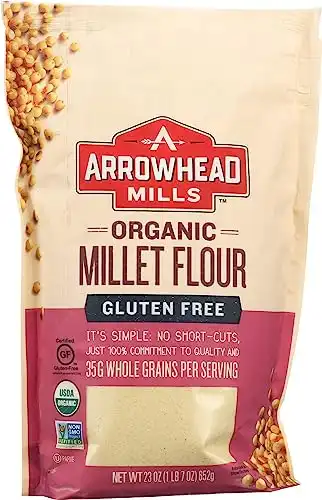Millet flour is made from a tiny, round little millet seed that has a variety of uses in cooking. The seeds are often ground into flour and substituted for wheat flour. You can also use them to make porridge, flatbreads, and other baked goods.
We have studied millet for its benefits as a health food and foraging in recent years. Its high tryptophan content has been linked to reduced symptoms of depression and anxiety, and we have found it to help people with diabetes control their blood glucose levels. Researchers have also found that millet has many health benefits for people with high cholesterol and obesity.
Millet is an excellent source of minerals, magnesium, manganese and phosphorus, which are essential for bone health and linked to decreased risk of osteoporosis. Millet also contains antioxidants, which may help protect your cells from damage caused by free radicals. Free radicals are molecules that can damage your cells and lead to chronic diseases such as cancer.
This article will explain more about Millet Flour's use, advantages and disadvantages.
- What Is Millet Flour?
- Why Is Millet Flour Important?
- How to Use Millet Flour to Support Anti-Aging
- What Are the Disadvantages of Millet Flour?
- What Are the Advantages of Millet Flour?
- Millet Flour Contains Antioxidants
- Millet Flour Is Anti-Carcinogenic
- Millet Flour Is an Anti-Inflammatory Grain
- Millet Flour Improves Skin Elasticity
- Millet Flour Reduces the Risk of Cancer
- Millet Flour Promotes Weight Loss
What Is Millet Flour?
Millet is a tiny grain cultivated in India and China for thousands of years. It is a staple food in many parts of Asia, Africa, and Latin America. Millet is considered one of the least allergenic grains, making it a popular choice for people with celiac disease or gluten sensitivity.
It's believed that millet may be one of the oldest crops known to man, making it one of the oldest grains. They domesticated millet in the Neolithic and later in the Second Chinese Dynasty, and it is an integral part of the diet in northwest China. They widely grew it in western Europe at one time, but farmers reduced millet production due to extensive potato growth. As a result, it was practically extinct by the mid-Twentieth Century.
Millet is a gluten-free grain in several varieties, including pearl, proso, foxtail, finger and Kodo millet. The most commonly consumed type in the United States is pearl millet. In Asia and Africa, they often eat millet as bread. In the United States, it's usually ground into flour or used in birdseed.
Besides being a source of carbohydrates, fiber, and protein, millet contains several other beneficial nutrients for health. It's packed with vitamins B1, B2, and B6. These vitamins are essential for normal cell function and metabolism. In addition, millet is also rich in magnesium, phosphorus and potassium, which are important for good health.
Millet contains amino acids and proteins that promote skin elasticity. They also have L-lysine, which aids in the production of collagen and reduces fine lines, scars, and age spots. Millet can improve blood circulation and stimulate hair growth. A high-fiber diet can also reduce wrinkles. The benefits of millet flour are many. It can improve your overall health.
Millet Flour We Love
-
$18.49 ($0.39 / Ounce)Buy Now
by Anthony's
We earn a commission if you make a purchase, at no additional cost to you.
03/07/2024 08:48 am GMT -
$9.52 ($0.41 / Fl Oz)Buy Now
by Arrowhead Mills
We earn a commission if you make a purchase, at no additional cost to you.
03/06/2024 08:00 pm GMT -
$14.99 ($0.47 / Ounce)Buy Now
by Food to Live
We earn a commission if you make a purchase, at no additional cost to you.
03/06/2024 07:47 pm GMT
Why Is Millet Flour Important?
The benefits of Millet are numerous. For starters, this grain helps increase the rate of blood circulation, which may reduce the risk of atherosclerosis. Additionally, the magnesium and potassium in millet help lower blood pressure, reducing the risk of heart attacks and strokes. As you can see, millet is an excellent addition to any healthy diet. And because of its low glycemic index, it may help you maintain a healthy blood sugar level.
Besides providing essential nutrients, millet is rich in fiber and protein. It is also gluten-free and suitable for a variety of diets. It has a delicate flavor, and you can use it in bread, porridges, side dishes and desserts. While they often associate millet with the ancient African huts, it is also becoming increasingly popular in many western countries. You can find millet in many varieties, including white, gray and red.
Millet contains L-lysine and L-proline, which help the body produce collagen. Collagen helps the skin retain its firmness and prevents wrinkles. We also know this grain to help people avoid constipation, as it contains both soluble and insoluble fiber. This helps your body to eliminate waste. Because of its many benefits, millet is becoming an increasingly popular grain.
In addition to its anti-inflammatory properties, millet is also an excellent source of dietary fiber. As long as you're aware of your carbohydrate intake, you can enjoy the benefits of millet. This grain also helps your hair grow thicker and more robust. In addition, by promoting blood circulation on your scalp, millet is an excellent addition to any diet. It may even prevent balding!
How to Use Millet Flour to Support Anti-Aging
This multigrain flour is a great way to ward off the effects of aging, as well as provide a boost to your immune system. While you may not have realized it, millet contains various essential vitamins and minerals. It's an excellent source of dietary fiber, magnesium and iron, which can all help to keep your system healthy and robust.
When cooking millet, it has a fluffy texture, and its surface is similar to that of white rice. Typical cooking instructions call for millet to be rinsed and drained before adding to a recipe. Millet flour is a suitable replacement for rice, and you can use it in pancakes, bread and other baked goods. You can also use it as a crust for pizza and veggie patties. Its nutty flavor makes it a perfect choice for those looking for a supplement that can help fight age.
If you're concerned about the effects of aging, you might use millet as a healthy food for your aging skin. It's a whole grain containing approximately 22 percent of your daily value (DV) of iron. In addition, millet is high in fiber, promoting digestion and supporting a healthy microbiome. Aside from this, millet flour is inexpensive and versatile.
What Are the Disadvantages of Millet Flour?
Millet is one of the most nutritious and healthy cereal grains available. It is a whole grain packed with fiber, protein and antioxidants. It can be ground into flour or eaten as a hot breakfast cereal. You can also purchase millet in puffed form, similar to rice cakes. They sell millet in many health food stores and supermarkets. It comes in puffed, dried or ground forms. While it contains few health risks, it can be an allergy trigger for some people.
Millet contains some disadvantages for aging people. It can cause gas for those who do not eat enough fiber. In addition, the abundance of fiber in millet may cause nausea and cramping if you are not used to it. Other disadvantages of millet include high phytic acid content, which binds with minerals, such as zinc and calcium, making them unavailable for absorption. Phytic acid can also cause flatulence and stomach upset because it reduces the activity of digestive enzymes.
While millet is beneficial for the digestive system, we should not eat it as a sole source of nutrition.
What Are the Advantages of Millet Flour?
Millet Flour promotes skin elasticity, helps prevent atherosclerosis, and reduces fine lines. It also reduces blood pressure, enhances complexion and helps prevent sun damage. Millet Flour also strengthens hair follicles and improves blood circulation, stimulating hair growth. However, its benefits outweigh its disadvantages.
In addition to lowering diabetes risk, millet flour can help you lose weight. This is because it contains high amounts of magnesium, which improves glucose-receptor efficiency in the body. In addition, millet is a gluten-free grain that has some anti-inflammatory properties.
Millet Flour Contains Antioxidants
Millet flour is high in antioxidants, stabilizing lipids and suppressing excessive cellular redox processes. In addition, the plant contains high levels of phenolic compounds, which are considered "lifespan essentials" that help maintain the health benefits of the body even in the later stages of life. We find these compounds in millet grains' soluble and insoluble phenolic extracts. They also possess antioxidant, chelation and reducing capabilities.
The seed coat of millet is the most nutritious part of the grain, containing high levels of polyphenols and phytochemicals. These compounds contribute to the antioxidant activity of the plant, which is an essential factor in health, aging, and metabolic conditions. They've also studied the plant's nutritional benefits extensively. For example, millet is a source of relief for people who have celiac disease, a condition caused by gluten intolerance.
Millet Flour We Love
-
$18.49 ($0.39 / Ounce)Buy Now
by Anthony's
We earn a commission if you make a purchase, at no additional cost to you.
03/07/2024 08:48 am GMT -
$9.52 ($0.41 / Fl Oz)Buy Now
by Arrowhead Mills
We earn a commission if you make a purchase, at no additional cost to you.
03/06/2024 08:00 pm GMT -
$14.99 ($0.47 / Ounce)Buy Now
by Food to Live
We earn a commission if you make a purchase, at no additional cost to you.
03/06/2024 07:47 pm GMT
Millet Flour Is Anti-Carcinogenic
Finger millet is a grain crop with wholesome traits that are a good match for the global nutritional infirmity. Nevertheless, we still do not fully understand its nutraceutical potential. To advance this field, it is essential to understand its nascent significance.
Among its benefits, millet is gluten-free and pest-resistant. In addition, it contains B vitamins and magnesium, essential co-factors in hundreds of body processes, including energy production and metabolism, blood pressure regulation and muscle function. In addition, it may reduce the risk of heart disease and cancer. So, if you're looking for an alternative flour to wheat or rice, consider millet.
Another benefit of millet flour is its ability to reduce inflammation. Those with diabetes, prediabetes, and other chronic diseases are more likely to experience high levels of inflammation. By reducing inflammation, millet helps control blood glucose levels. Moreover, it contains magnesium, which helps cells respond to insulin. Also, millet has a low glycemic index, which lowers blood sugar levels more than wheat and rice.
Millet grains are rich in bioactive compounds, which inhibit cancer development. Researchers from Japan have investigated millet bran extracts that reduce inflammatory and anti-inflammatory cytokines. In addition, millet bran inhibits the production of cholesterol-producing enzymes, which are responsible for the body's immune responses.
Millet Flour Is an Anti-Inflammatory Grain
Many people are eating millet for its health benefits. This grain has become more popular and may be a substitute for wheat and rice. The anti-inflammatory properties of millet flour make it easy to digest and less prone to digestive upsets. It is also more accessible for people with chronic conditions to digest and has more protein than many other grains.
Besides its nutrient content, millet has also been beneficial for those with Type 2 Diabetes. For example, one study showed that diabetic mice fed with Japanese millet protein concentrate showed a higher HDL cholesterol level and increased levels of the hormone adiponectin, which is essential for energy metabolism. Although this research was only conducted only on Japanese Millet, it shows similar results for the Korean Proso Millet, commonly sold in the United States.
A recent study on millet flour found that it contains phenolic compounds, a class of antioxidants. These compounds donate hydrogen atoms to electron-deficient free radicals and form the resonance-stabilized phenoxyl radical. As a result, millet flour can inhibit the production of both inflammatory and anti-inflammatory cytokines, making it a valuable tool for fighting age.
Millet Flour Improves Skin Elasticity
To have firm and plump skin, you must have a skincare routine that helps your skin retain the water it needs. Skin can lose its elasticity with age if you do not properly hydrate your body. You can start keeping your skin supple by changing your daily routine a bit. You can use foods like millet flour to help your skin become firmer in cleaning and moisturizing.
Millet flour, made from the grains of certain grasses, is used to make bread and other baked goods. It's also used as a thickener for soups and stews. Millet flour has many benefits when used as part of a skincare routine. It's an antioxidant and an anti-inflammatory that contains vitamin B6 for healthy skin, selenium for cell repair and zinc for immune system support.
The best way to use millet flour for skincare is by making a mask out of it. When mixed with water, it forms a paste that you can spread onto your face and neck area in a thin layer. Leave the mask on for about 20 minutes before rinsing with warm water. Use this type of mask once or twice a week for the best results.
While it is true that we get older, the elasticity of our skin decreases. The skin cells that keep it smooth and tight break down. This breakdown occurs because of various stressors, including sun exposure and smoking. Fortunately, several skincare products can help you boost skin elasticity and slow down the signs of aging. Lifestyle factors, such as exercise and proper nutrition, can also contribute to a youthful appearance.
Changing your diet is an excellent way to improve skin elasticity. Adding Millet Flour makes sure you are getting plenty of vitamins and antioxidants. Millet is rich in vitamins and antioxidants, and they can use it in pretty much anything from cakes and cookies to bread and pancakes. The next time you're baking something special—or when you just want some thicker gravy—try replacing part of the flour with millet flour and see how much better it tastes.
Millet Flour Reduces the Risk of Cancer
We believe the consumption of millet reduces the risk of cancer. When consumed in moderation, it is safe for humans, and they have used it for thousands of years. However, we know excessive millet consumption to have adverse health effects, including the formation of goitrogen, which affects the thyroid gland's ability to produce hormones. People with goiter, an enlarged thyroid gland, suffer from dry skin, slow thinking and anxiety.
In addition to reducing cancer risk, millet is rich in fiber and niacin. Niacin plays a vital role in 400 enzyme reactions in the body and supports healthy skin and organ function. It is also a substantial source of magnesium, which plays a critical role in the body's processes. It also helps regulate blood pressure and energy levels and reduce fatigue.
Millet Flour Promotes Weight Loss
Millet is rich in nutrients and phytochemicals. The millet seed coat contains dietary fiber, vitamins, minerals, and phenolics. These compounds have health benefits and are beneficial adjuncts in special food preparation. In addition, they have the highest content of omega-3 fatty acids of any grain. This makes them a good choice for those who want to lose weight and age gracefully, and the great news is millet is available in grocery stores and online.
People with thyroid issues should avoid millet flour. There is also a risk of goiter, which is an enlargement of the thyroid gland. People with goiter can have depression and have slow thinking. This ancient grain is rich in fiber, magnesium, phosphorus, iron, zinc and selenium, supporting healthy brain function.
Besides its ability to promote weight loss, millet also has anti-inflammatory properties. In addition, its high dietary fiber content is beneficial for the body as it helps prevent gastrointestinal disorders. Millet is also rich in dietary fiber and is suitable for controlling various conditions, from aging and Type 2 Diabetes to heart disease. If you have diabetes or are looking for an alternative diet, try incorporating millet into your daily routine. It will change your life in ways you never knew possible.
Another great benefit of millet flour is that it contains prebiotics, which help the body grow probiotic bacteria. These bacteria play a critical role in the health benefit of our gut. In addition, those with celiac disease may find millet helpful because it is gluten-free and has a high nutrient content. Millet also helps control blood sugar levels and improves insulin sensitivity in people with diabetes.












